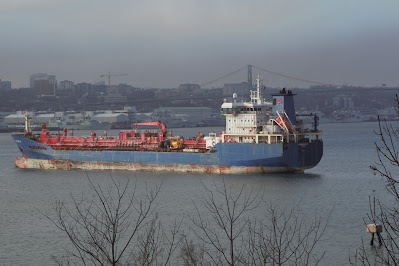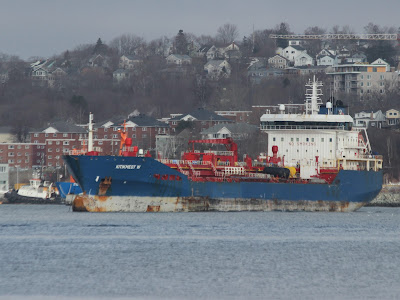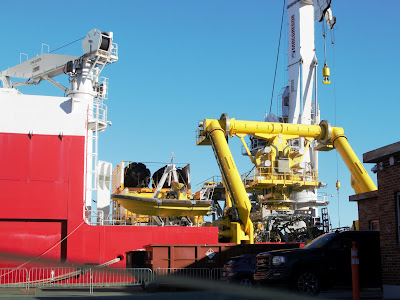1. Mostly good news on the Northumberland Strait
As a bit of an update on the previous post, November 13, the Northumberland Ferries Ltd service did resume on December 4 after repairs to the Confederation's bow door and hull. The resumption was a day or two later than anticipated but celebrations were short lived. A "load sharing" problem which prevented the main engines from running in sync resulted in the cancellation of further crossings after only one trip.
The ship was removed from service after aliding with the dock in Caribou, NS on September 15. The bow door had to be removed to be repaired, but the hull puncture was above the waterline so could be repaired with the ship afloat. That meant ten weeks out of service for the ship. some of which was covered by the rented Saarema 1 but it had reliability issues and was returned to Quebec.
The Confederation, with bow door removed, alongside Pictou Shipyard on Ocotber 22.
The load sharing problem on the Confederation was resolved after a day but then bad weather resulted in another shutdown. I don't normally report on weather shutdowns on that route, which are quite common due to the exposed positions of the terminals.
Northumberland Ferries Ltd then increased the number of daily sailings from three, the usual number at this season of the year, to four to compensate to a degree for the several service disruptions this year. On December 18 it was announced that the season would be extended from the usual December 20 shut down to December 23, again to provide better access to the mainland from Eastern Prince Edward Island. There will be four crosssings a day until December 22, then only two from Wood Island and one from Caribou on December 23.
Service normally resumes in May after the Northumberland Strait is clear of ice.
The "new" second ferry for the Strait service, the Northumberland, completed sea trials in Norway at the end of November and was registered in Ottawa December 12. (It is owned by the Minister of Transport and will be operated by Northumberland Ferries Ltd). It was built in 2006 and has been reconditioned over the past few months. It was named Fanafjord when built by Aker Tulcea in Romania and completed by Brattvaag Skipswerft in Norway. The 6904 gt ship carried the name Greenferry 1 between 2021 and 2022. Most sources give its capacity at 589 passengers and 212 cars, but that may change.
2 Bad and Good? News on the St.Lawrence River
A. The veteran St.Lawrence River ferry Trans-St-Laurent (built in 1963) soldiers on with remarkably few cancellations, and those usually weather related at this time of year. The seasonal service between Rivière-du-Loup on the South Shore to St-Siméon on the North Shore usually shuts down for the winter soon after New Year's Day. This year however there is an early halt, but not through any fault of the ship.
It was announced of December 17 that the service has been suspended for the balance of the season due to a fault in the hydraulic operating system of the boarding ramp at Rivière-du-Loup. Repairs could not be completed before the normal closing date, and it was decided to shut down early.
The crossing is usually very busy during the Christmas season, and will result in significant detours for travellers. The nearest ferry is the Matane to Baie Comeau and Godbout ship. It is a 200 km drive to Matane from Rivière-du-Loup. (The seasonal ferry between Trois-Pistoles and Escoumins is nearer, but closes at the end of October.) The nearest River crossing to the west is at Quebec a 385 km diversion from Rivière-du-Loup to St-Siméon, half of which is on the torturous two lane Route 138, and not exactly a pleasure cruise in winter.
B. REVISED with apologies
The shut down notice was preceeded by another eagerly awaited announcement. It has been decided not to relocate the south shore ferry terminal from Rivière-du-Loup to Cacouna - at least not before as of 2028. (That may be the year when the Trans-St-Laurent replacement enters service.) The Saarema I, operated by the Société des traversiers du Québec, will replace the Trans St-Laurent in 2018 when the current contract with Clarke, owners and operators of the Trans St-Laurent expires.
Pressure for a year round service - for which no announcement has been made nor whether the new ship will be ice rated - has been steady over the years, but the current terminal location, due to shallow water in the area can not be used when ice is present. It is also costly to dredge the channel to the current terminal every year due to siltation. Cacouna does not require dredging, and could be used all year, but building a ferry terminal in the port would also be costly and there would be serious conflicts with the commercial port activity there. There are no services near Cacouna, whereas there are numerous motels, restaurants, service stations and shopping centres in Rivière-du-Loup, and most public and business opinion in the area was against the Cacouna location. See addendum below
An all season terminal at Rivière-du-Loup seems unlikely, so the Trans-St-Laurent replacement may not be much different in function if not in appearance - homely though it is.
Addendum
I was mistaken when I originally made this post, and in fact the Province of Quebec announced that the ferry terminal will be moved from Rivière-du-Loup to Gros Cacouna as of 2018. A temporary boarding ramp and facilities will be built at Cacouna for use of the ferry Saaremaa 1 which will replace the Trans-St-Laurent in 2018 on expiry of the current contract with Clarke. A permanent terminal, to the east of the commercial facilities will be completed by 2031. [That may be when a new ship is delivered.] The Saaremaa I carries 110 vehicles and 600 passengers (but has only 300 seats), which is more than the Trans St-Laurent at 100 cars and 400 passengers. Lets hope its recent engine repairs will make it more reliable than it was on the Northumberland Strait last summer.
Reasons for the move include the total cost of the move - quoted as $474.5 million - still much less than keeping the terminal in Rivière-du-Loup due to the high cost of annual dredging at the existing terminal. Dredging also disturbs the habitat of beluga whales that live in the area..
The present hour and ten minutes crossing will be twenty minutes longer from Cacouna to St-Siméon. I expect the ship will still sail west of Ile-aux-Lièvres using the same course that it does now.

The Saaremaa I will replace the Trans-St-Laurent in 2018.
The announcement also stated that there will not be year round service, although I believe that may change in 2031.
I apologize for this error.
1978 photo shows the Trans-St-Laurent pretty much as built. There have been some superficial changes such as a passenger elevator, but the huge open lifeboats have not been replaced with rafts and aircraft type evacuation slide system.
.




























